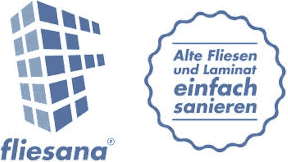FAQs
frequently asked Questions
Frequently asked questions: Pollutants:- formaldehyde free
- lead free, no heavy metals
- solvent-free
- no harmful plasticizers
- low VOC emission
In which hardware store can I get the tiles and planks?
- These tiles are currently only available in our online shop or if you pick them up yourself from our factory.
Is the gluing service offered?
Wir vermitteln Verlegebetriebe in Ihrer Region. Bitte schreiben Sie uns unter einkauf (at) fliesana.com eine Nachricht mit diesen Informationen:
- Größe des Badezimmers in Quadratmetern
- Küberitschinen gewünscht?
- Soll Boden und Wände saniert werden?
- Postleitzahl und Ort
Which substrates can the boards and tiles be glued to?
- on all non-absorbent surfaces such as tiles, PVC and laminate
- The substrates should be level, as we cannot guarantee liability for uneven tiles with, for example, relief or wave structures. It is advisable to order a sample and to check the liability in a practical test and to decide at your own discretion.
- You should refrain from gluing on wallpaper, screed, plasterboard, Fermacell or OSB boards, as the tiles and floorboards will not adhere to the sub-floor without pre-treatment.
What measures have to be taken before laying?
- It is very important to clean the surfaces to be pasted over so that they are ultimately free of grease, dust and dirt. This is the only way to guarantee an absolutely reliable bond strength.
- When laying on the floor, we recommend leveling out the tile joints by filling in order to prevent them from showing. We will soon be launching our own product for filling joints. Like our self-adhesive tiles and floorboards, it will also be removable.
Can the tiles also be glued in a shower cubicle?
- Yes, thanks to the foil seal that protrudes on two sides, the foils stick together in a watertight manner when they are laid. However, it is important to seal the corners and outer edges with a good sanitary silicone. Acrylic is unsuitable for this purpose.
What alternatives are there to silicone for inside and outside corners?
- For a beautiful finish of the outside corners, we recommend Küberit rails or Tappezierschinen, which you can get in a well-stocked DIY store or specialist painter's market. They are available in various materials, colours and side lengths. These rails are attached before the installation of Fliesana.
- There are also conventional aluminium rails in various sizes available in DIY stores that can be retrofitted. To attach them, apply silicone to the inner angle and glue it to the outer edge. Excess silicone can be easily removed with a silicone remover profile.
Are the tiles and floorboards also suitable for underfloor heating?
- Yes, our tiles are resistant up to 28 ° C.
- They are not suitable for installation in winter gardens, balconies or open terraces.
- Based on this frequently asked question, we have developed a product that is specially tailored to the needs of tenants. Since all previous solutions for leveling the joints cannot be dismantled, after some time of development we have now developed the removable joint filler FUGOFILL. With this product, the existing joints can be filled, thus reliably preventing unsightly pressing through or marking of the tile joints.
Are there any other sizes or decors?
- No, because we are bound to specified dimensions and decors through our supplier of the blanks.
Delivery abroad
- Switzerland
- Austria
- Denmark
- Poland
- Italy
- Sweden
- Netherlands
- France
- Luxembourg
- Finland
- Norway
Can the tiles and floorboards be removed without leaving any residue?
- Yes, even after years, the tiles and floorboards can be removed without leaving any residue.
- Should there be any adhesive residue on a tile, it can be rubbed off with a label remover.
1 to 2 (from a total of 2)

